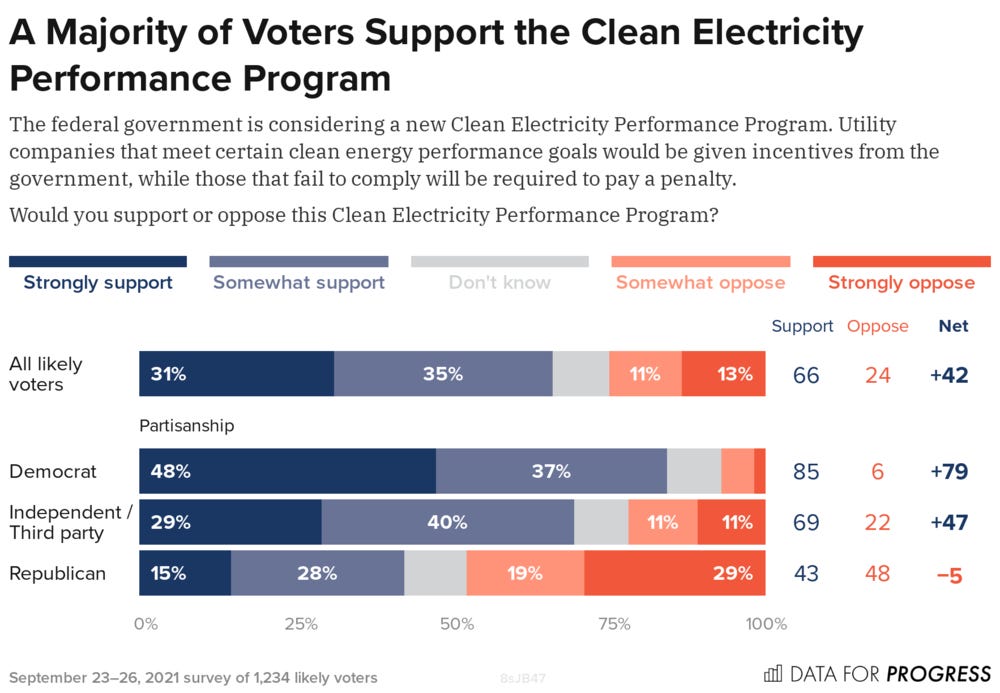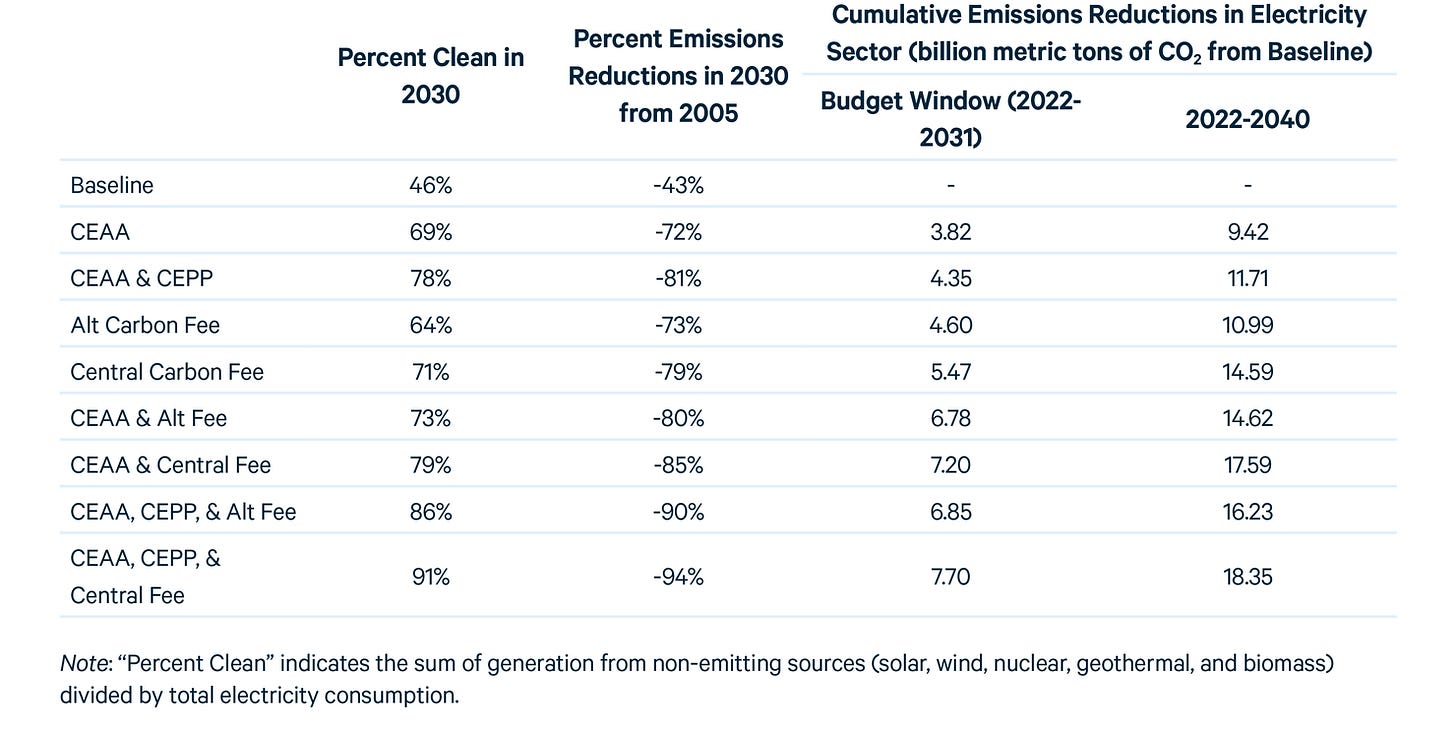Last week, Sen. Joe Manchin (D-WV) finally stopped playing games and said that he will not vote for a budget reconciliation bill that contains the Clean Electricity Performance Program (CEPP).
You can read my interview with Sen. Tina Smith (D-MN) for more on the CEPP and this post to understand why it is so centrally important to serious climate policy. I won’t get into all those arguments again. Suffice it to say, it’s a good policy and losing it is bummer.
Insofar as Manchin has offered any reason for killing the CEPP, it is an alleged concern over “using taxpayer dollars to pay private companies to do things they’re already doing.”

But that is just incorrect.
Utilities are not “already doing” what the CEPP requires, i.e., increasing their share of clean energy 4 percentage points year-on-year, every year. Only a tiny handful of the nation’s thousands of utilities are on that trajectory.
The sector as a whole is slowly decarbonizing, but the whole point of the policy is to accelerate the process to meet US carbon targets.
Manchin knows that. It’s precisely what he’s trying to prevent. He told CNN flat out, “I'm not going to sit back and let anyone accelerate whatever the market's changes are doing.”
Why not? Well, he wants to keep fossil fuel power plants open, which is incompatible with Biden’s publicly stated goal of 50 to 52 percent carbon reductions from 2005 levels by 2030.
Manchin is standing up for local fossil fuel interests (including his own) against the president, 49 of his colleagues in the Democratic caucus, a majority of legislators in the House, a majority of voters, and even a majority of West Virginia voters.
He also wants to slash the child tax credit. He’s just a jerk. It is what it is.
At this point, it’s unclear what will and won’t survive into the final Build Back Better Act (or whether there will be a final bill at all). Reports are that staffers are scrambling to find ways to make up the lost emission reductions through other policies.

The question is, how big of a hole are they trying to fill? How big a hit is it to lose the CEPP?
A few analyses released in the past week are helpful in getting our heads around this.
Energy Innovation says the loss of CEPP could cost the bill up to 35% of its emission reductions
The first is from research firm Energy Innovation, which uses its Energy Policy Simulator to determine how much emissions would be reduced by the policies in the House Democrats’ version of the Build Back Better Act and the bipartisan infrastructure bill that was passed by the Senate over the summer.
Obviously, predicting circumstances a decade hence is a fraught undertaking. Energy Innovation ran four scenarios: a business-as-usual scenario, with only existing policies, and low, moderate, and high emission-reduction scenarios based on different assumptions about the price of energy and the efficacy of various provisions in the bills.
They didn’t model all the policies in the bills, just the ones that are relatively easy to quantify. Some emission reductions have gone uncounted, so the estimates Energy Innovation produced are almost certainly a lower bound.
Here are the topline results:
In the high scenario, clean energy reaches an 85 percent share of US electricity by 2030; in the moderate scenario, it’s 80 percent; in the low scenario, about 70 percent.
As you can see in the moderate scenario below, by far the biggest tranche of emission reductions (about half) would come from the combination of the CEPP and clean-energy tax credits:
The good news is that passing both bills could, “with supporting state and regulatory policy,” at the high end of the high emission reduction scenario, just barely get the US to its 2030 target. That’s if everything is included in the bills.
The question now is, what do those numbers look like without the CEPP?
Luckily, Energy Innovation ran a couple of variations of its moderate scenario with no CEPP (a high one, which assumes tax credits are maximally effective, and a low one, with lower take-up of tax credits).
Long story short, “emissions are likely to be 250 to 700 MMT higher per year in 2030” than they would be with the CEPP, “which could eliminate more than a third of the total emissions reductions under the Infrastructure Bills.”
As the scenarios show, a great deal depends on factors that can’t be precisely predicted: the price of fossil fuels, the cost curves of clean technologies, and the efficacy and impact of the clean-energy tax credits and other BBB policies. The loss of the CEPP could reduce the emissions impact of the bill anywhere from 20 to 35 percent.
Resources For the Future agrees but says a carbon fee could make up for it
Energy Innovations’ findings jibe with the second analysis, from Resources for the Future (RFF). RFF modeled three policies, in various combinations:
the clean-energy tax credits, which it calls CEAA for the “Clean Energy for America Act,” a bill from Sen. Ron Wyden (D-OR) that is largely included in the BBB Act;
the Clean Electricity Performance Program (CEPP); and
a carbon tax (er, fee) — the “central” carbon fee “starts at 15 $/metric ton and increases gradually to 30 $/metric ton by 2028, followed by a $10 annual increase through the end of the modeling period (2045).”
The CEAA tax credits alone, without the CEPP, gets the electricity sector to a 69 percent clean energy share by 2030. That is roughly in line with Energy Innovations’ high-end estimation of the tax credits’ impact.
The CEAA plus the CEPP gets the sector to 78 percent clean energy — a 9 point bump.
The CEAA, CEPP, and the central carbon fee together get to 91 percent.
RFF’s model, like Energy Innovations’, shows that the tax credits are doing the bulk of the work. From a baseline (no policy) scenario, the tax credits take the clean-energy share in 2030 from 46 to 69 percent (+23); with the CEPP, it goes from 69 to 78 percent (+9).
Notably, in RFF’s modeling, the tax credits plus a central carbon fee get the number to 79 percent — in other words, a carbon fee pretty neatly substitutes for the CEPP, emissions-wise.
Nonetheless, despite some recent chatter, Manchin has already put the kibosh on the prospect of a carbon fee as well.


Rhodium Group says the US climate target is still within reach
Can the US get on track to its 2030 target without the CEPP? For some insight on that we turn to the other recently released analysis, from the research firm Rhodium Group.
It sets out to determine whether the US can hit its target (again, 50 to 52 percent reductions from 2005 levels by 2030) with what it calls a “joint action scenario,” which includes “actions by all key actors in the US federal system, including legislation under construction in Congress, regulations and other actions that can be taken by the Biden administration and key departments, as well as actions by climate-leading states and corporations.”
Importantly, though it is capacious, the joint action scenario is deliberately conservative about policy out of Congress, given Manchin’s well-known Manchinness: “We include tax credit extensions, clean energy grant programs, and spending on agricultural programs, but do not include a carbon or methane fee or the CEPP [my emphasis].”
The good news is that the CEPP-less joint action scenario gets the US to its goal, or at least close to it.
Even without the CEPP, it is the electricity sector that provides most of the reductions:
One reason there are so many reductions in the electricity sector — and this brings us to what I suppose is the bad news — is that the joint action scenario includes a lot of policies, including standards on new and existing power plants from EPA. Getting to the US target requires all levels of government and the private sector to act with immediate ambition.
This is the action required by Congress:
This is the action required by the executive branch:
And this is what’s required of “subnational groups,” i.e., states, cities, and companies:
If all of that comes together, then the US can hit its 2030 climate target without the CEPP.
Rhodium stresses that the joint action scenario is not the only path to that goal — the final section of its analysis suggests a range of other policies that could also help — but any path to the goal involves coordinated action taken on numerous fronts at once … and a lot of luck.
Where does this leave us?
For years now, it’s been one of the climate world’s great rituals: after every new setback, delay, or disappointment, there’s a rush of articles and models showing, “We can still do it! It’s not impossible yet!”
I suppose this is another one of those posts. Even without the CEPP, the two infrastructure bills passed together would reduce emissions considerably. The loss of the CEPP would take a big chunk out of those emission reductions — more than a third, if things go poorly — but there’s a chance some of that can be made up with other policies.
This is assuming the BBB bill doesn’t get worse. Manchin may not be done screwing it up yet. The top priority now should be protecting the full range of clean-energy tax credits and ensuring that a) they extend at least 10 years and b) they are fully refundable.
And other policies must be protected as well. Here, according to Energy Innovation, are the next most effective policies after the CEPP + tax credits.
The second strongest provision is the fee on oil and gas methane emissions, which contributes about 12 percent of total reductions, or 165 MMT in 2030. Incentives for electric vehicles (EVs) and charging equipment are next, at 115 MMT in 2030, or 9 percent of total reductions.
I tend to doubt Congressional staffers will be able to find anything new that’s big enough to compensate for the loss of the CEPP, but Biden can also gain back some of those reductions through aggressive use of the EPA and other agencies. We’ll see if he has the moxie to do that.
The US doesn’t need to worry that hitting its target is unaffordable. All three analyses show that decarbonizing the electricity sector will reduce consumer energy costs, and that’s not even including the enormous benefits of reduced air pollution, which themselves would easily pay for the transition.
Nonetheless, rapid decarbonization is a huge, wrenching socioeconomic transformation. Hitting our target would be a heroic feat. The fastest the US has ever reduced emissions, outside of a recession, is 4.1 percent in 2012. To get to 50 percent reductions by 2030, Rhodium says, “requires a 5.2-5.6 percent year-on-year cut in emissions every year.” We have to go faster than we’ve ever gone, every year from now through 2030.
And that’s only the first, and arguably easiest, step. The first 50 percent of reductions will be easier than the last 50 percent, which we need to eliminate by 2050. That will require new policies, technologies, and industries.
In the grand scheme of things, the loss of the CEPP is not the end of the world, as irritating and indefensible as it is. As long as Manchin doesn’t do any more damage, as long as staffers scrabble together a few compensatory policies, as long as Biden uses executive agencies aggressively, as long as states, cities, and businesses continue acting ambitiously … well, as long as all of that happens, we still have a shot.


























Share this post